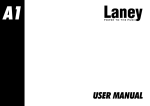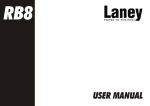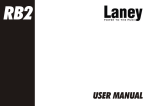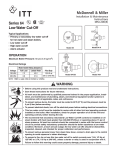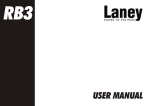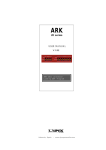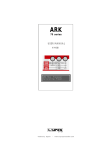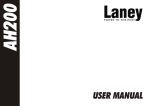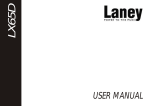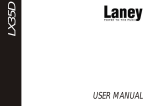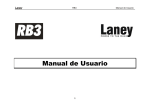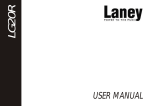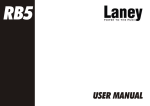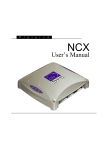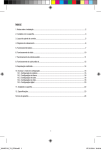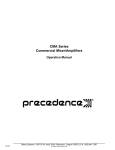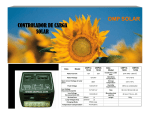Download A1 Manual - 2006 - Issue 2.cdr
Transcript
A1 USER MANUAL IMPORTANT SAFETY INSTRUCTIONS WARNING: When using electric products, basic cautions should always be followed, including the following. 1. Read all safety and operating instructions before using this product 2. The product should be powered by a three pin `grounded (or earthed) plug connected to a power socket with a grounded earth outlet. 3. All safety and operating instructions should be retained for future reference 4. Obey all cautions in the Operating instructions and on the back of the unit 5. All operating instructions should be followed 6. This product should not be used near water, i.e. a bathtub, sink, swimming pool, wet basement, etc. 7. This product should be located so that its position does not interfere with its proper ventilation. It should not be placed flat against a wall or placed in a built up enclosure that will impede the flow of cooling air. 8. This product should not be placed near a source of heat such as stove, radiator, or another heat producing amplifier. 9. Connect only to a power supply of the type marker on the unit adjacent to the power supply cord. 10. Never break off the ground pin on a power supply cord. 11. Power supply cords should always be handled carefully. Never walk or place equipment on power supply cords. Periodically check cords for cuts or signs of stress, especially at the plug and the point where the chord exits the unit. 12. The power supply cord should be unplugged when the unit is to be unused for long periods of time. 13. If this product is to be mounted in an equipment rack, rear support should be provided. 14. The user should allow easy access to any mains plug, mains coupler and mains switch used in conjunction with this unit thus making it readily operable. 15. Metal parts can be cleaned with a damp cloth. The vinyl covering used on some units can be cleaned with a damp cloth or ammonia based household cleaner if necessary. Disconnect the unit from the power supply before cleaning. 16. Care should be taken so that objects do not fall and liquids are not spilled into the unit through any ventilation holes or openings. On no account place drinks on the unit. 17. A qualified service technician should check the unit if: The power cord has been damaged Anything has fallen or spilled into the unit The unit does not appear to operate correctly The unit has been dropped or the enclosure damaged. 18. The user should not attempt to service the equipment. All service work is done by a qualified service technician. 19. Exposure to extremely high noise levels may cause a permanent hearing gloss. Individuals vary considerably in susceptibility to noise induced hearing loss, but nearly everyone will lose some hearing if exposed to sufficiently intense noise for a sufficient time. The U.S. Government's Occupational Safety and Health Administration (OSHA) has specified the following permissible noise level exposure. Duration Per Day In Hours Sound Level dBA, slow response 8 90 6 92 4 95 3 97 2 100 1½ 102 1 105 ½ 110 ¼ or less 115 According to OSHA, any exposure in excess of the above permissible limits could result in some hearing loss. Ear plugs or protectors in the ear canals or over the ears must be worn when operating this amplification system in order to prevent a permanent hearing loss if exposure exceeds the limits set forth above. To ensure against potentially dangerous exposure to high sound pressure levels it is recommended that all persons exposed to equipment capable of producing high sound pressure levels such as this amplification system be protected by hearing protectors while this unit is in operation. SAVE THESE INSTRUCTIONS Page 2 /16 Page 3 /16 Laney OPERATING INSTRUCTIONS BEFORE SWITCHING ON After unpacking your amplifier check that it is factory fitted with a three pin 'grounded' (or earthed) plug. Before plugging into the power supply ensure you are connecting to a grounded earth outlet. If you should wish to change the factory fitted plug yourself, ensure that the wiring convention applicable to the country where the amplifier is to be used is strictly conformed to. As an example in the United Kingdom the cable colour code for connections are as follows. EARTH OR GROUND - GREEN/YELLOW NEUTRAL - BLUE LIVE - BROWN NOTE This manual has been written for easy access of information. The front and rear panels are graphically illustrated, with each control and feature numbered. For a description of the function of each control feature, simply check the number with the explanations adjacent to each panel. Your Laney amplifier has undergone a thorough two stage, pre-delivery inspection, involving actual play testing. When you first receive your Laney Bass amp, follow these simple procedures: (i) Ensure that the amplifier is the correct voltage for the country it is to be used in. ii) Connect your instrument with a high quality shielded instrument cable. You have probably spent considerable money on your amplifier and guitar - don’t use poor quality cable it won’t do your gear justice. Please retain your original carton and packaging so in the unlikely event that some time in the future your amplifier should require servicing you will be able to return it to your dealer securely packed. Care of your Laney amplifier will prolong it's life.....and yours! Page 4 /16 Laney OPERATING INSTRUCTIONS Dear Player, Thank you very much for purchasing your new Laney product and becoming part of the worldwide Laney family. Each and every Laney unit is designed and built with the utmost attention to care and detail, so I trust yours will give you many years of enjoyment. Laney products have a heritage which stretches back to 1967 when I first began building valve amplifiers in my parent’s garage. Since then we have moved on from strength to strength developing an extensive range of guitar, bass, public address and keyboard amplification products along with a list of Laney endorsees that includes some of the world’s most famous and respected musicians. At the same time we believe we have not lost sight of the reason Laney was founded in the first place - a dedication to building great sounding amplification for working musicians. Warm Regards, Lyndon Laney CEO INTRODUCTION The A1 is a dedicated 65W acoustic amplifier loaded with a 10 inch loudspeaker and a high frequency horn in a kickback style cabinet. Its features include; three separate channels; balanced DI out; Headphone socket; FX Loop and Tuner out. Channel one has an instrument input socket; switchable pad; switchable compressor; comprehensive EQ system; notch filter; phase switch; volume control and mute switch with status light. Channel two features a mic input; high impedance input; volume control; two band EQ and mute switch with status light. Channel three features a CD input with level control. Finally the A1 comes equipped with a 24bit digital signal processor with 16 programs and level control, which can be assigned to channels 1+2 independently. An explanation of these features follows on pages 6-8. Page 5 /16 Laney 1 2 OPERATING INSTRUCTIONS 3 7 8 9 10 11 12 13 15 16 18 19 4 5 6 14 17 FRONT PANEL CONTROLS 1 Socket provided for connecting your instrument. Only use good quality screened cable. Determines the level of compressor/preamp gain. The more the compressor gain control is increased the more 2 compression it gives. The resulting effect is that the volume level heard does not change so much with playing weight. This has several benefits; picking and full on chords will be heard at similar levels; excessive low frequencies will be reduced giving an apparent brighter & punchier sound; uncontrolled low frequency feedback will be reduced and increased sustain on single notes can be obtained. There are two LEDs associated with the compressor, one showing the compressor is switched on this will illuminate whether the compressor is physically active or not. The active LED actually shows when the Compressor is working and compressing the signal. 3 The pad switch allows you to reduce (or pad down) the input level from a guitar with an active pickup system, or a particularly loud passive pickup to prevent the guitar from overloading the preamplifier of the A1. 4 Lights when the onboard compressor is actively compressing the signal. Compressor must be switched in with 5 Switch in to activate the onboard compressor, this compresses the input signal giving a punchier sound. The amount of compression is controlled by The higher the setting the more compression. With most guitars compression will begin at about 5-6 on the control. It is possible to have the compressor engaged but it only be active during certain periods of playing - typically the most dynamic sections. 6 Lights when the compressor is switched in ready for operation. 7 The Enhance control provides an increased definition at the low-end of the frequency spectrum giving you a tighter, punchier 6 4 5 2 Page 6 /16 Laney 8 9 10 11 12 13 14 15 16 17 18 19 OPERATING INSTRUCTIONS sound. The Enhance control does this by providing a dip in the frequency-response of the amplifier at approximately 250Hz. This dip reduces some of the harmonics of the important low-frequencies around 80-120 Hz producing better definition to your sound. Turning the control through to its maximum has the effect of boosting both the low and high-frequency content. Active Bass control allowing boost and cut of the low-frequency response of the pre-amplifier. Selects the mid-frequencies (200Hz to 9KHz) to be cut or boosted in conjunction with the paramid level control Boosts or cuts the chosen frequency set by To boost the chosen frequency turn the control clockwise, to cut the chosen frequency turn anticlockwise. Active Treble control allowing boost or cut of the high frequency response of the pre-amplifier. This is an active filter control that allows you to boost the high frequencies around 10KHz. It can be used to add a high end piezo/bowlback characteristic to the amplifiers response. Switches the phase of the signal from the amplifier. When you play any acoustic guitar the sound it produces is a waveform, the same applies to an acoustic guitar plugged into an acoustic amplifier. It is not uncommon for these two waveforms which occur simultaneously be out of phase with each other. To a player who is sat close to an amplifier this poses a small problem if the wave forms are out of phase as they are destructive to each other and cancel each other out. This would cause the guitar to sound a little thin and lack-lustre. Engaging the phase switch switches the phase of the amplified signal removing the problem of destructive interference. However sometimes the low frequencies being in phase can cause acoustic feed back problems, to avoid this try operating the phase reversal switch. Most times this will cure the problem. One thing to point out is that the audience does not hear any phase problems as by the time the sound wave reaches them any phase differences have been cancelled out naturally. The Notch filter can be switched in and out here and adjusted with to eliminate the "body resonance" feedback often associated with amplified acoustic guitar at high volume levels. To eliminate "body resonance" feedback switch the filter in with and adjust this control until the body resonation reduces, you should find a sweet spot on the control where it disappears. Turning further out of the sweet spot will bring the resonation back up again. This setting will be the optimum for that particular guitar but may need to be altered if you plug in another guitar. Sets the volume of the instrument plugged into channel 1. Led is lit when channel 1 is muted (with ) Mutes whatever instrument is connected into channel 1. Led is lit when muted. Sets the overall listening volume of the amplifier. Make sure the channel volumes are not set too low ( ) Page 7 /16 10 9 15 14 18 17 16 22 27 Laney 20 21 OPERATING INSTRUCTIONS 22 23 24 25 26 27 28 29 30 31 32 33 34 35 FRONT PANEL CONTROLS - continued 20 1 Balanced input provided for connecting an XLR equipped input such as a low impedance microphone ( 200-600 Ohms) or a DI’d guitar etc. Input provided for connecting high impedance microphones or sources that require a high impedance connection and are 21 fitted with a 1/4” jack - such as an additional guitar, bass or drum machine. 22 Sets the volume of the instrument(s) plugged into channel 2. 23 Sets the bass response for whatever is connected to channel 2. 24 Sets the treble response for whatever is connected to channel 2. 25 Led is lit when channel 2 is muted (with ) 26 Mutes whatever instrument is connected into channel 2. Led is lit when muted. 27 Sets the volume of what ever source is plugged into (Channel 3) 28 RCA/Phono connections provided for connecting an external sound source such as a CD, Mini Disc or MP3 player etc. 29 Assigns the chosen effect ( ) to channel 1. 26 25 28 32 Page 8 /16 Laney OPERATING INSTRUCTIONS FRONT PANEL CONTROLS - continued 30 Assigns the chosen effect ( ) to channel 2. 31 1 Sets the level from the onboard digital effects section, present in the overall mix. The onboard digital effects have been custom designed by Laney to complement the A1. You have a choice of delays, flange, 32 rotary, octave, chorus, reverb and combinations of these. Select the chosen effect here, and set the level with This XLR socket provides a low impedance output for direct injection of the amplifier signal to a mixing desk or power 33 amplifier. It is taken after the main mix stage, but prior to the main volume control. 34 When ‘on’ Indicates that power is connected to the unit and it is ready to go. (Always switch off and disconnect the power cord when not in use) 35 Main power switch for the unit. 32 31 PIN CONNECTIONS 1 2 Input/Output Jacks 3 1 3 1 2 2 Mic in XLR DI Out XLR Pin 1 = Gnd Pin 2 = Hot Pin 3 = Cold Page 9 /16 Laney 1 OPERATING INSTRUCTIONS 2 3 4 5 6 7 REAR PANEL CONTROLS 1 Power inlet socket. Connect to your power source. Make sure the specified voltage is correct for your country! 2 This drawer contains the main safety fuse for the unit. USE ONLY THE CORRECT SIZE AND RATING OF FUSE AS SPECIFIED ON THE PANEL. The mains fuse ratings are detailed in the specs section at the rear of this manual. Serial Number and model of your unit. 3 4 5 Connect your external electronic tuner here. This signal is taken before the mute/volume stages allowing silent tuning. (Ch 1 only) 6 FX Send socket provided for connecting to external effects units input socket. You can also use the send socket as a line out if you wish. 7 Connect the output of your external effects unit here. Any external effects device used here will affect both channels of the A1. Can be used in addition to the onboard digital effects. Page 10 /16 Socket for connecting a pair of quality headphones. When in use, the internal loudspeaker is automatically muted. Laney OPERATING INSTRUCTIONS OTHER FEATURES Your A1 features a kickback style design to enable you to use it as a stage monitor, or a conventional straight combo. GENERAL NOTES Amplifier connection: In order to avoid damage, it is advisable to establish and follow a pattern for turning on and off your equipment. With all system parts connected, turn on source equipment, tape decks, cd players, mixers, effects processors etc. BEFORE turning on your Bass Amplifier. Many products have large transient surges at turn on and off which can cause damage to your speakers. By turning on your Bass Amplifier LAST and making sure its Volume control is set to minimum any transients from other equipment will not reach your loudspeakers. Wait until all system parts have stabilised; usually a couple of seconds. Similarly when turning off your system always turn down the Volume control on your Bass Amplifier and then turn off its power before turning off other equipment. Cables: Always use good quality shielded cable for your instrument and small signal connections. Never use shielded or microphone cable for any speaker connections as this will not be substantial enough to handle the amplifier load and could cause damage to your amplifier system. Caution: These professional loudspeaker systems are capable of generating very high sound pressure levels. Use care with placement and operation to avoid exposure to excessive levels that can cause permanent hearing damage. (Refer to guidelines on page 2) Page 11 /16 Laney OPERATING INSTRUCTIONS SAMPLE SYSTEM - 1 Tuner Input Page12 /16 Laney OPERATING INSTRUCTIONS Input Output SAMPLE SYSTEM - 2 Tuner Input Page 13 /16 Laney OPERATING INSTRUCTIONS BLOCK DIAGRAM CHANNEL 1 MUTE VOLUME ACTIVE EFFECTS PHASE REVERSAL PHASE REVERSE NOTCH FREQUENCY NOTCH SECTION NOTCH ON/OFF TREBLE EQ SECTION BASS ENHANCE COMPRESSOR ON/OFF GAIN CHANNEL 2 MIC INPUT ENHANCE MID LEVEL COMPRESSOR SECTION PAD MAIN ON MID SWEEP ACTIVE CHANNEL 1 INPUT PROGRAM SELECT INTERNAL EFFECTS EFFECTS LEVEL ASSIGN FX CHANNEL1 MUTE ACTIVE TUNER OUT EQ SECTION TREBLE BASS GAIN CHANNEL 2 HIZ INPUT D.I. OUT ASSIGN FX CHANNEL 2 CD IN LEVEL This loop is a series type so all your signal will go through your FX unit. FX LOOP MAIN MIX STAGE SEND RETURN HEADPHONE SOCKET POWER ON MUTE INTERNAL LOUDSPEAKER POWER AMP MASTER VOLUME HPF INTERNAL HORN CLIP LIMITER SECTION Page 14 /16 Laney OPERATING INSTRUCTIONS SPECIFICATIONS Supply Voltage Mains Fuse Power Consumption Output Power Rating THD%+N Loudspeaker Channel 1 Features Channel 2 Features Channel 3 Features D.I. Tuner Out FX Loop Other Features Size Unit Weight Packing Weight ~100V, ~120V, ~220V, ~230V, ~240V 50/60Hz Factory Option ~220V>~240V = T1A L. ~100>~120V = T2A L (Time delay) 120W 65W Typically <0.03% 10” Custom Designed Driver + high frequency horn Input Socket (Sensitivity 170mV -13dBu (comp/gain at 0) (Sensitivity 11mV -37dBu (comp/gain at 10) (Input Impedance 10Meg Ohm + 47pF) Pad Switch (-6dBu) Switchable Compressor with status lights Enhance Bass (±10dB at 70Hz, Shelving) Treble (±15dB at 10KHz, Shelving) Brilliance (±10dB at 12KHz Peaking) Paramid sweep (±10dB at 200Hz > 9KHz Peaking) Mic Input (Sensitivity 10mV -40dBu Balanced 1K) HiZ Instrument Input (40mV 27dBu, Impedance 1Meg + 47pF) Bass (±10dBu at 70Hz Shelving) Treble (±10dBu at 10KHz Shelving) Dual RCA Input (250mV -10dBu, Impedance 10K) Yes, Balanced XLR (250mV -10dBu Typical) Yes (2*Instrument level (1* with pad in) CH1 only Yes (700mV 0dBu) (Zout 2K, Zin 10K) (Series-Insert) Power amplifier clip distortion limiter Dual purpose kickback style cabinet Dual ported, reflex loaded cabinet design 420*385*365 (H*W*D) 13.5Kg (Kg) 15.0Kg (Kg) This product conforms to: European EMC directive(2004/108/EC), Low Voltage Directive (72/23/EEC) and CE mark Directive (93/68/EEC) Page 15 /16 Laney POWER TO THE MUSIC METAL BLUES JAZZ ROCK AMPICONS ARE HERE TO HELP! @ In the interest of continued product development, Laney reserves the right to amend product specification without prior notification.
















